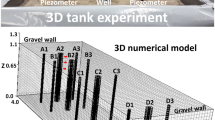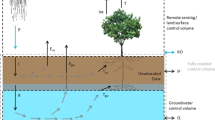Abstract
Groundwater discharge through evaporation due to a shallow water table can be an important component of a regional scale water balance. Modeling this phenomenon in irrigated regions where soil moisture varies on short time scales is most accurately accomplished using variably saturated modeling codes. However, the computational demands of these models limit their application to field scale problems. The MODFLOW groundwater modeling code is applicable to regional scale problems and it has an evapotranspiration package that can be used to estimate this form of discharge, however, the use of time-invariant parameters in this module result in evaporation rates that are a function of water table depth only. This paper presents a calibration and validation of the previously developed MOD-HMS model code using lysimeter data. The model is then used to illustrate the dependence of bare soil evaporation rates on water table depth and soil moisture conditions. Finally, an approach for estimating the time varying parameters for the MODFLOW evapotranspiration package using a 1-D variably saturated MOD-HMS model is presented.











Similar content being viewed by others
References
Allen, RG, Pereira LS, Raes D, Smith M (1998) Crop evapotranspiration – guidelines for computing crop water requirements – FAO irrigation and drainage paper 56. FAO – Food and Agricultural Organization of the United Nations, Rome
Banta ER (2000) Modflow 2000, the U.S. Geological Survey modular ground-water model – documentation of packages for simulating evapotranspiration with a segmented function (ETS1) and drains with return flow (DRT1). Open File Report 00-466. U.S. Geological Survey, Washington, DC, p 127
Belitz K, Phillips SP, Gronberg JM (1993) Numerical simulation of ground-water flow in the central part of the Western San Joaquin Valley, California. U.S. Geological Survey Water-Supply Paper 2396. Sacramento, Ca., p 69
Eching SO, Hopmans JW, Wallender WW, MacIntyre JL, Peters D (1994) Estimation of local and regional components of drain-flow from an irrigated field. Irrig Sci 15:153–157
Gardner WR (1958) Some steady-state solutions of the unsaturated moisture flow equation with application to evaporation from a water table. Soil Sci 85:228–232
Gardner WR, Fireman M (1958) Laboratory studies of evaporation from soil columns in the presence of a water table. Soil Sci 85:244–249
Jorenush MH, Sepaskhah AR (2003) Modelling capillary rise and soil salinity for shallow saline water table under irrigated and non-irrigated conditions. Agric Water Manag 61:125–141
Katul GG, Parlange MB (1992) A Penman–Brutsaert model for wet surface evaporation. Water Resour Res 28:121–126
McDonald MG, Harbaugh AH (1988) A modular three-dimensional finite-difference ground-water flow model. In: Techniques of water resources investigations of the United States geological survey, Book 6, chap. A1, U.S. Geol. Surv., Washington, DC.
Panday S, Huyakorn PS (2004) A fully coupled physically-based spatially-distributed model for evaluating surface/subsurface flow. Adv Water Resour 27:361–382
Parlange MB, Katul GG, Cuenca RH, Kavvas ML, Nielsen DR, Mata M (1992) Physical basis for a time series model of soil water content. Water Resour Res 28:2437–2446
Parlange MB, Katul GG, Folegatti MV, Nielsen DR (1993) Evaporation and the field scale soil water diffusivity function. Water Resour Res 29:1279–1286
Prathapar SA, Robbins CW, Meyer WS, Jayawardane NS (1992) Models for estimating capillary rise in a heavy clay soil with a saline shallow water table. Irrig Sci 13:1–7
Ritchie JT (1972) Model for predicting evaporation from a row crop with incomplete cover. Water Resour Res 8:1204–1213
San Joaquin Valley Drainage Program (1990) A management plan for agricultural subsurface drainage and related problems on the westside San Joaquin Valley. San Joaquin Valley Drainage Program, Sacramento, CA, p 183
Saravanapavan T, Saluvucci GD (2000) Analysis of rate-limiting processes in soil evaporation with implications for soil resistance models. Adv Water Resour 23:493–502
Šimůnek J, Šejna M, van Genuchten MTh (1998) The HYDRUS-1D software package for simulating the one-dimensional movement of water, heat, and multiple solutes in variably-saturated media, Version 2.0, IGWMC- TPS-70. International Ground Water Modeling Center, Colorado School of Mines, Golden, Colorado, pp 202
Soppe RWO, Ayars JE (2003) Characterizing ground water use by safflower using weighing lysimeters. Agric Water Manag 60(1):59–71
Tarboton KC (1997) Integrated hydrological model for irrigation drainage management. Doctoral Dissertation, University of California, Davis. Davis, CA, p 362
Wallender WW, Grimes DW, Henderson DW, Stromberg LK (1979) Estimating the contribution of a perched water table to the seasonal evapotranspiration of cotton. Agron J 71:1056–1060
Watermark Numerical Computing (2002) PEST – Model independent parameter estimation. Watermark Numerical Computing, p 279
Yang J, Li B, Liu S (2000) A large weighing lysimeter for evapotranspiration and soil–water–groundwater exchange studies. Hydrol Process 2000:1887–1897
Acknowledgements
We would like to acknowledge the suuport of the USDA Fund For Rural America, the USBR Fresno office, and the UC Salinity Drainage Program.
Author information
Authors and Affiliations
Corresponding author
Rights and permissions
About this article
Cite this article
Young, C., Wallender, W., Schoups, G. et al. Modeling shallow water table evaporation in irrigated regions. Irrig Drainage Syst 21, 119–132 (2007). https://doi.org/10.1007/s10795-007-9024-4
Received:
Accepted:
Published:
Issue Date:
DOI: https://doi.org/10.1007/s10795-007-9024-4




